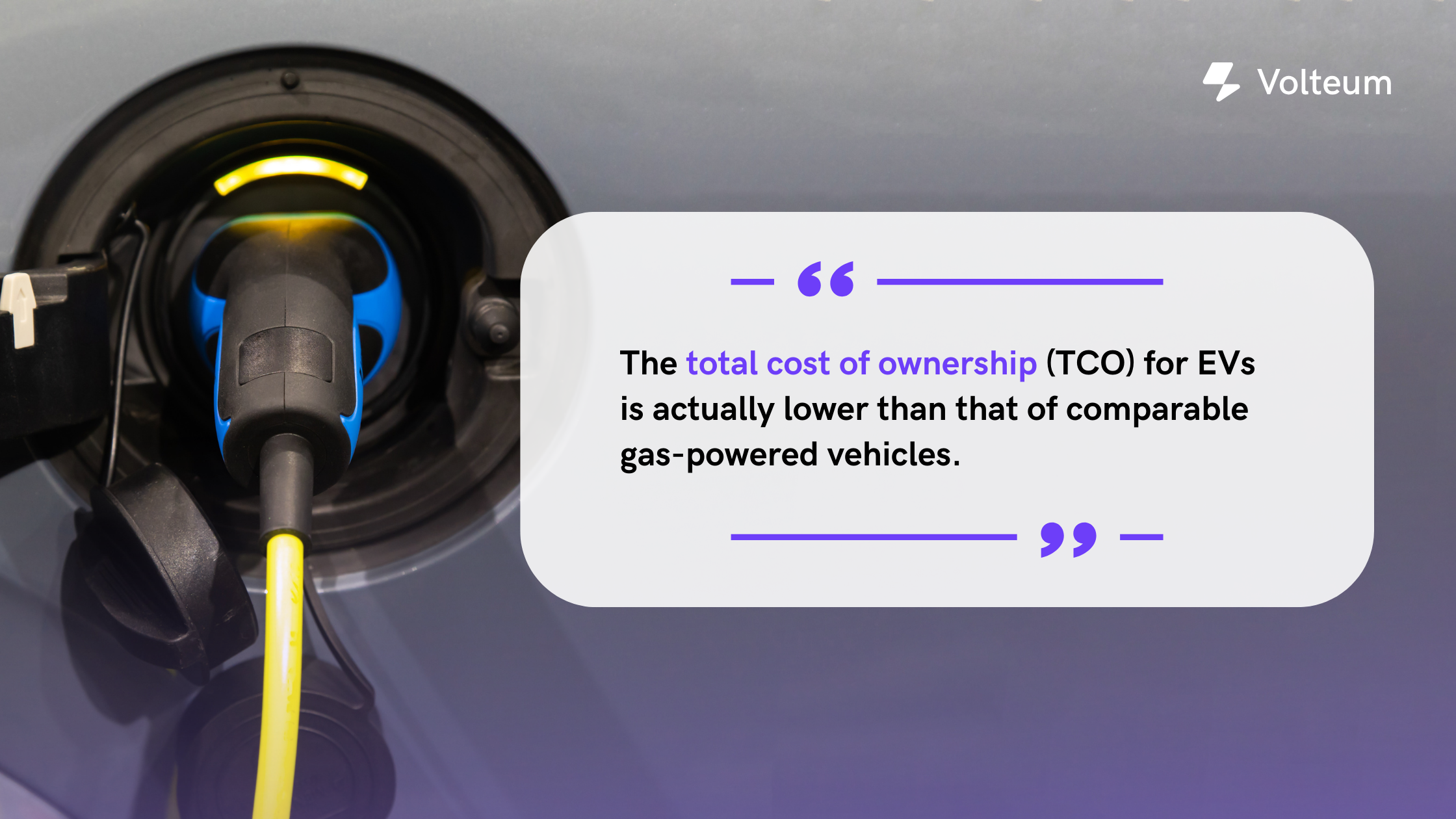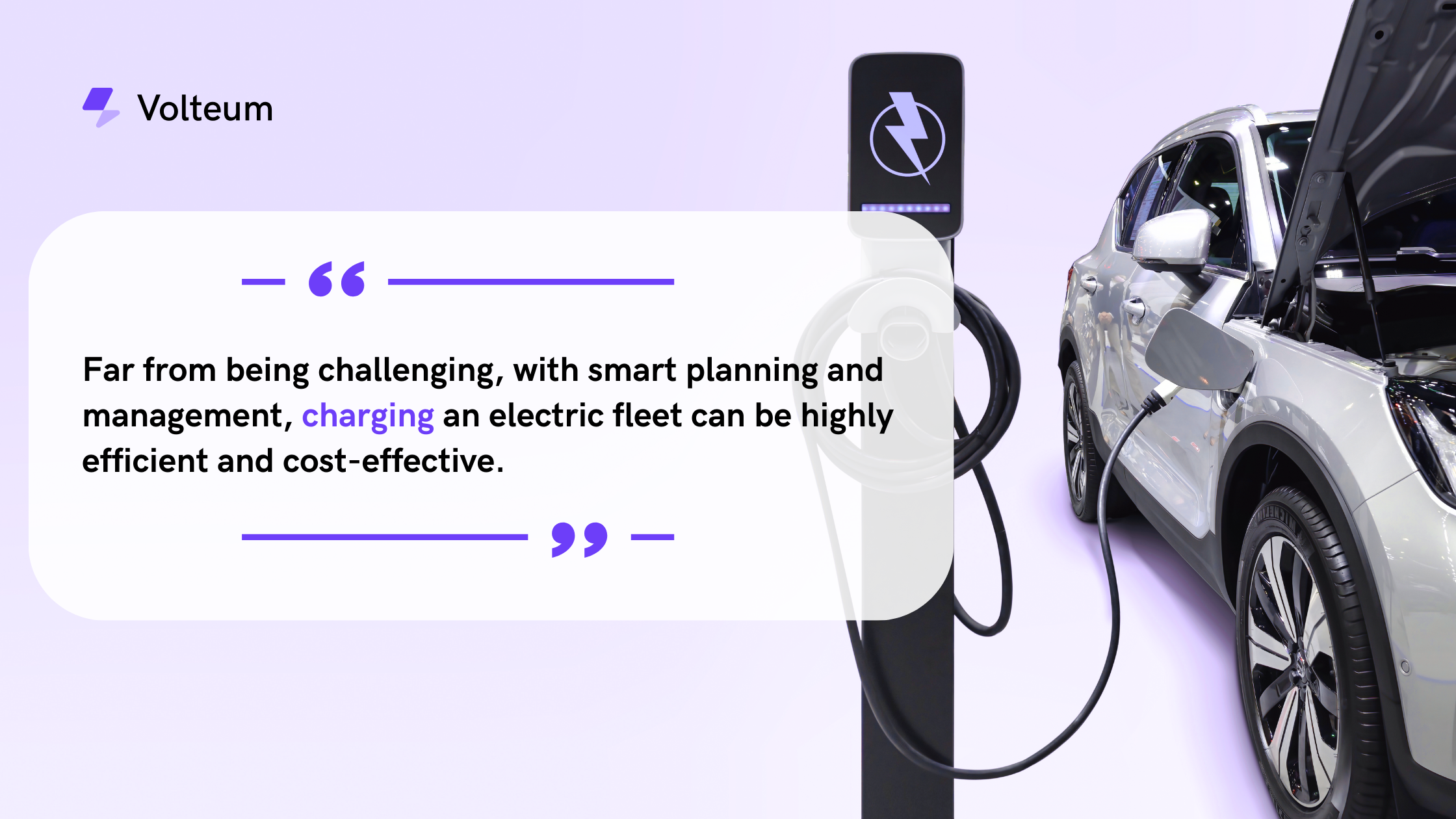The truth about electric fleets: Debunking 4 major myths
Jan 15, 2024 · 7 min read · blog
The transportation industry is in the midst of a revolution as fleets transition to zero-emission electric vehicles. Misconceptions about electric fleet capabilities and costs have slowed adoption, but the facts paint an entirely different picture, as advancements in battery technology, charging infrastructure, and vehicle ranges are accelerating the transition to electric.

This article debunks four of the most pervasive myths surrounding EV fleets to provide an unvarnished look at the opportunities and challenges of going electric.

Myth #1: EVs are too expensive for fleets

It is a common misconception that electric vehicles are too expensive for commercial fleets to adopt. However, the total cost of ownership (TCO) for EVs is actually lower than that of comparable gas-powered vehicles. While the upfront costs of EVs may be higher, the long-term savings in fuel and maintenance help offset initial investments.

- For commercial fleets, the potential savings are even greater given the high mileage vehicles accumulate. For example, the average fleet driver in the U.S. travels around 20,000–25,000 miles per year, so fuel costs constitute a major portion of operating expenses. Switching to electricity can reduce annual fuel costs by up to 50-70% compared to gas.
- EVs also have lower maintenance costs. They do not require oil changes or tune-ups and have fewer moving parts, so repair costs are less frequent and less expensive - even up to 30% less compared to traditional vehicles.
- In addition, there are federal, state and local incentives that can reduce the purchase price of EVs and charging equipment for commercial fleets. The U.S. federal tax incentive offers a credit of up to $7,500 per vehicle for light-duty EVs. Many states match or exceed this amount.

While EVs may have higher upfront costs, the significant long-term savings in fuel and maintenance along with available purchase incentives mean lower total costs of ownership for commercial fleets. The benefits to the environment and energy security are substantial. The truth is, EVs make both economic and environmental sense for businesses.



Myth #2: EV fleet charging is challenging

One common myth surrounding electric vehicle fleets is that charging them is challenging and inconvenient. However, for most fleets, installing and managing EV charging is quite straightforward.

- Charging options abound: There are several options for fleet charging that make the process simple. Level 2 charging stations can fully recharge an EV overnight and are easy to install in a fleet yard or garage. For faster turnaround, DC fast charging stations can provide an 80% charge in around 30 minutes. Fleets can choose to install their own charging stations or use public charging networks and stations.
- Smart charging management: With smart charging management technology, fleets can optimize when and how EVs charge. Software can schedule charging during off-peak hours when energy is less expensive. It can also balance the power load by managing how many EVs charge at once. Some systems even allow fleets to monitor usage and costs in real-time to better understand their EV fleet’s charging needs and impacts.
- Planning ahead for infrastructure: While setting up charging infrastructure for an EV fleet does require initial planning and investment, the long-term benefits to both operations and the environment make it worthwhile. Fleets should evaluate their vehicles’ daily usage and mileage to determine how many chargers they need and the optimal charging locations before transitioning to EVs. With the right planning and technology, keeping an electric fleet charged can be simple and affordable.

Myth debunked: far from being challenging, with smart planning and management, charging an electric fleet can be highly efficient and cost-effective. The benefits of transitioning to EVs far outweigh the initial investments in time and resources to set up the necessary charging infrastructure.



Myth #3: EVs don't have enough range for fleets

This myth stems from the early days of EVs when batteries were still developing and ranges averaged only about 100 miles (160 km) on a single charge. Today, EV ranges have increased significantly, with many entry-level models achieving 150-200 miles (240-320 kilometers) or more per charge. Not to mention higher-end models that offer ranges well above 300 miles (480 kilometers), with some even exceeding 400 miles (640 kilometers) under optimal conditions. For fleets that operate locally or regionally, modern EV ranges are sufficient for daily driving needs.
Fleets concerned about range can implement strategies to extend EV driving distance. Choosing models with larger battery packs can provide more miles between charges. Route planning also helps maximize range by reducing unnecessary mileage. Additionally, opportunity charging during driver breaks or downtime can add range throughout the day.
While EVs may not yet match the range of gas-powered vehicles, their range continues to improve rapidly. For the typical driving distances of local and regional fleets, modern EVs have enough range to handle daily duties with opportunity and overnight charging. With larger batteries, strategic route planning, and available public/private charging infrastructure, EV range anxiety will soon be a thing of the past, even for fleets with more demanding range needs. The truth is, for most fleets, EVs absolutely have enough range to get the job done.



Myth #4: Maintenance costs are higher for EV fleets

It is commonly believed that electric vehicles are more expensive to maintain compared to gas-powered vehicles. However, this myth has been debunked by several studies of fleet maintenance costs. According to a paper from Consumer Reports, BEV and PHEV owners are paying 50% less than traditional car owners are paying to repair and maintain their vehicles.
BEVs have fewer moving parts than internal combustion engine vehicles, so they require less frequent oil changes and tune-ups. The regenerative braking system also reduces brake pad replacements. BEVs do not require smog checks or emission system repairs either.
Although BEV batteries will need to be replaced eventually, their lifetimes have been improving. The current estimates are that BEV batteries will last 10-15 years before significant degradation, although some automakers offer battery warranties for up to 8 years to ease customer concerns. While battery replacements are expensive, the overall lifetime maintenance costs of BEVs are still lower than gas-powered vehicles.
Fleet managers should not be deterred from transitioning to electric vehicles due to perceived higher initial costs. The myth that electric fleets cost more to maintain has been proven false by research and the experiences of fleets that have already made the switch to electric.



The future is electric: Embracing EV fleets

While myths about electric vehicles and fleets are common, the truth is far more compelling. Technology continues to rapidly improve, costs are declining, and infrastructure is expanding. Fleets that transition to electric vehicles today will benefit from lower operating costs, reduced emissions, an improved driver experience, and a boost in brand perception. The future is electric, and forward-thinking fleets will lead the charge. With hard data and real-world examples dispelling the myths, there's no reason fleets should hesitate to accelerate their adoption of electric vehicles. The transition is challenging but rewarding, and the companies that pursue it will thrive in the coming decades of sustainable transportation.